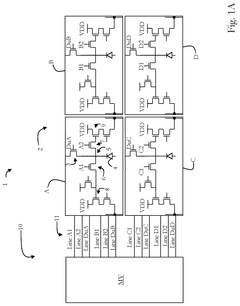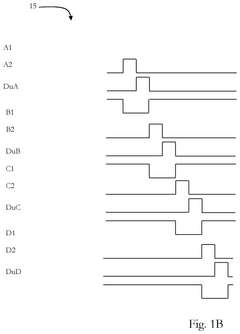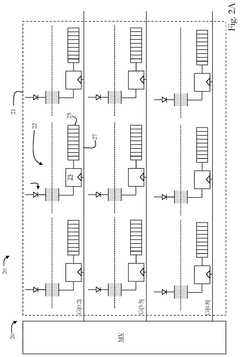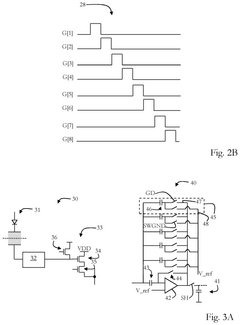Time-Of-Flight Ambient Light Rejection: Modulation, Filters And SNR
SEP 22, 20259 MIN READ
Generate Your Research Report Instantly with AI Agent
Patsnap Eureka helps you evaluate technical feasibility & market potential.
TOF Sensing Background and Objectives
Time-of-Flight (ToF) sensing technology has evolved significantly over the past two decades, emerging as a critical solution for depth perception in various applications. Initially developed for military and aerospace applications in the 1970s, ToF technology has transitioned into commercial applications with the miniaturization of components and reduction in manufacturing costs. The evolution trajectory shows a clear trend toward higher resolution, improved accuracy, and enhanced performance in challenging lighting conditions.
The fundamental principle of ToF sensing involves measuring the time taken for light pulses to travel from an emitter to an object and back to a sensor. This time measurement directly correlates to distance, enabling precise depth mapping. Modern ToF systems typically utilize infrared light sources modulated at specific frequencies, with specialized sensors designed to detect phase shifts in the returning light signals.
A critical challenge in ToF technology development has been ambient light rejection. Sunlight and artificial lighting introduce significant noise into ToF measurements, potentially overwhelming the sensor and reducing accuracy. This challenge becomes particularly acute in outdoor environments or brightly lit indoor spaces where ambient light intensity can be orders of magnitude greater than the ToF system's emitted signal.
The technical objective of ambient light rejection in ToF systems is to maximize the signal-to-noise ratio (SNR) by effectively distinguishing between the system's emitted light signal and unwanted ambient light. This involves sophisticated modulation techniques, optical filtering, and advanced signal processing algorithms working in concert to isolate the desired signal.
Current research and development efforts are focused on several key objectives: enhancing modulation schemes to better differentiate signal from noise, developing more selective optical filters that block ambient light while allowing system light to pass, and implementing advanced signal processing techniques that can extract meaningful data even in challenging lighting conditions.
The industry is witnessing a convergence of ToF technology with other sensing modalities, such as structured light and stereo vision, to create more robust depth sensing solutions. This multi-modal approach aims to leverage the strengths of each technology while mitigating their respective weaknesses, particularly in varying environmental conditions.
As applications for ToF technology expand into autonomous vehicles, robotics, augmented reality, and smart consumer devices, the demand for reliable performance across diverse lighting conditions continues to drive innovation in ambient light rejection techniques. The ultimate goal remains achieving high-precision depth sensing that maintains accuracy regardless of environmental lighting challenges.
The fundamental principle of ToF sensing involves measuring the time taken for light pulses to travel from an emitter to an object and back to a sensor. This time measurement directly correlates to distance, enabling precise depth mapping. Modern ToF systems typically utilize infrared light sources modulated at specific frequencies, with specialized sensors designed to detect phase shifts in the returning light signals.
A critical challenge in ToF technology development has been ambient light rejection. Sunlight and artificial lighting introduce significant noise into ToF measurements, potentially overwhelming the sensor and reducing accuracy. This challenge becomes particularly acute in outdoor environments or brightly lit indoor spaces where ambient light intensity can be orders of magnitude greater than the ToF system's emitted signal.
The technical objective of ambient light rejection in ToF systems is to maximize the signal-to-noise ratio (SNR) by effectively distinguishing between the system's emitted light signal and unwanted ambient light. This involves sophisticated modulation techniques, optical filtering, and advanced signal processing algorithms working in concert to isolate the desired signal.
Current research and development efforts are focused on several key objectives: enhancing modulation schemes to better differentiate signal from noise, developing more selective optical filters that block ambient light while allowing system light to pass, and implementing advanced signal processing techniques that can extract meaningful data even in challenging lighting conditions.
The industry is witnessing a convergence of ToF technology with other sensing modalities, such as structured light and stereo vision, to create more robust depth sensing solutions. This multi-modal approach aims to leverage the strengths of each technology while mitigating their respective weaknesses, particularly in varying environmental conditions.
As applications for ToF technology expand into autonomous vehicles, robotics, augmented reality, and smart consumer devices, the demand for reliable performance across diverse lighting conditions continues to drive innovation in ambient light rejection techniques. The ultimate goal remains achieving high-precision depth sensing that maintains accuracy regardless of environmental lighting challenges.
Market Analysis for TOF Ambient Light Rejection Solutions
The Time-of-Flight (ToF) ambient light rejection solutions market is experiencing robust growth, driven by increasing demand for 3D sensing technologies across multiple industries. The global ToF sensor market was valued at $2.8 billion in 2021 and is projected to reach $6.9 billion by 2026, representing a CAGR of 19.8%. Within this broader market, ambient light rejection technologies constitute a critical component, addressing one of the most significant challenges in ToF implementation.
Consumer electronics represents the largest market segment, with smartphone manufacturers integrating ToF sensors for facial recognition, augmented reality applications, and camera autofocus enhancement. Apple's implementation of LiDAR scanners in iPad Pro and iPhone Pro models has significantly validated the technology's value proposition in consumer devices, creating a ripple effect across the industry.
Automotive applications form the fastest-growing segment, with a projected CAGR of 23.5% through 2026. Advanced driver-assistance systems (ADAS) and autonomous driving technologies rely heavily on ToF sensors with robust ambient light rejection capabilities for reliable operation in varying lighting conditions. Major automotive suppliers including Bosch, Continental, and Valeo have made substantial investments in this technology.
Industrial automation represents another significant market, with ToF sensors being deployed for precise object detection, robot guidance, and quality control applications. The industrial segment values ToF solutions with superior ambient light rejection for maintaining operational accuracy in challenging factory environments with mixed lighting conditions.
Geographically, North America currently leads the market with approximately 35% share, followed closely by Asia-Pacific at 32%. However, Asia-Pacific is expected to overtake North America by 2025, driven by the region's dominance in consumer electronics manufacturing and rapid adoption of automation technologies in countries like China, Japan, and South Korea.
Key market drivers include the miniaturization of ToF modules, decreasing component costs, and increasing demand for contactless interfaces following the global pandemic. The development of more effective ambient light rejection techniques is creating new market opportunities by expanding ToF applications to outdoor environments and scenarios with challenging lighting conditions.
Market challenges include price pressure from competing technologies such as structured light and stereo vision systems, as well as technical limitations in extreme lighting conditions. The industry is responding through increased R&D investment in advanced modulation techniques, sophisticated filtering algorithms, and improved sensor designs to enhance SNR in the presence of ambient light interference.
Consumer electronics represents the largest market segment, with smartphone manufacturers integrating ToF sensors for facial recognition, augmented reality applications, and camera autofocus enhancement. Apple's implementation of LiDAR scanners in iPad Pro and iPhone Pro models has significantly validated the technology's value proposition in consumer devices, creating a ripple effect across the industry.
Automotive applications form the fastest-growing segment, with a projected CAGR of 23.5% through 2026. Advanced driver-assistance systems (ADAS) and autonomous driving technologies rely heavily on ToF sensors with robust ambient light rejection capabilities for reliable operation in varying lighting conditions. Major automotive suppliers including Bosch, Continental, and Valeo have made substantial investments in this technology.
Industrial automation represents another significant market, with ToF sensors being deployed for precise object detection, robot guidance, and quality control applications. The industrial segment values ToF solutions with superior ambient light rejection for maintaining operational accuracy in challenging factory environments with mixed lighting conditions.
Geographically, North America currently leads the market with approximately 35% share, followed closely by Asia-Pacific at 32%. However, Asia-Pacific is expected to overtake North America by 2025, driven by the region's dominance in consumer electronics manufacturing and rapid adoption of automation technologies in countries like China, Japan, and South Korea.
Key market drivers include the miniaturization of ToF modules, decreasing component costs, and increasing demand for contactless interfaces following the global pandemic. The development of more effective ambient light rejection techniques is creating new market opportunities by expanding ToF applications to outdoor environments and scenarios with challenging lighting conditions.
Market challenges include price pressure from competing technologies such as structured light and stereo vision systems, as well as technical limitations in extreme lighting conditions. The industry is responding through increased R&D investment in advanced modulation techniques, sophisticated filtering algorithms, and improved sensor designs to enhance SNR in the presence of ambient light interference.
Current Challenges in TOF Ambient Light Rejection
Time-of-Flight (ToF) systems face significant challenges in ambient light rejection, which directly impacts their accuracy and reliability in real-world applications. The primary obstacle stems from the overwhelming intensity of ambient light compared to the active illumination signal. In outdoor environments, sunlight can be several orders of magnitude stronger than the modulated light source used by ToF sensors, resulting in signal drowning and reduced detection capabilities.
Conventional filtering techniques show limitations when dealing with broadband ambient light sources. Optical bandpass filters, while effective for narrowband interference, struggle with sunlight that spans across the spectrum including the near-infrared region where many ToF systems operate. This spectral overlap makes complete optical filtering practically impossible without also attenuating the desired signal.
Temporal noise presents another significant challenge. The shot noise generated by ambient photons introduces statistical fluctuations that degrade the signal-to-noise ratio (SNR). This effect becomes particularly problematic in high dynamic range scenes where bright ambient conditions exist alongside areas of interest with lower reflectivity.
The modulation schemes currently employed face inherent trade-offs between ambient light rejection capability and other performance metrics. Higher modulation frequencies can improve ambient light discrimination but may reduce the maximum measurable distance or require more sophisticated electronics. Phase-based methods suffer from phase wrapping issues when ambient light causes detector saturation.
Power consumption constraints further complicate ambient light rejection strategies. Mobile and battery-powered ToF applications cannot simply increase illumination power to overcome ambient light, as this would drastically reduce operational time and potentially violate eye safety regulations.
Temperature-induced drift in both the illumination source and detector response creates additional complications for ambient light rejection algorithms. As components heat up during operation, their characteristics change, potentially invalidating calibration parameters used in ambient light compensation techniques.
Multi-path interference compounds with ambient light problems, creating scenarios where both effects must be addressed simultaneously. Current algorithms that handle one effect often break down when both are present, requiring more complex computational approaches that may not be feasible for real-time applications.
The computational overhead of advanced ambient light rejection techniques presents implementation challenges for embedded systems. Many sophisticated algorithms require substantial processing power, making them impractical for cost-sensitive consumer applications or systems with strict latency requirements.
Conventional filtering techniques show limitations when dealing with broadband ambient light sources. Optical bandpass filters, while effective for narrowband interference, struggle with sunlight that spans across the spectrum including the near-infrared region where many ToF systems operate. This spectral overlap makes complete optical filtering practically impossible without also attenuating the desired signal.
Temporal noise presents another significant challenge. The shot noise generated by ambient photons introduces statistical fluctuations that degrade the signal-to-noise ratio (SNR). This effect becomes particularly problematic in high dynamic range scenes where bright ambient conditions exist alongside areas of interest with lower reflectivity.
The modulation schemes currently employed face inherent trade-offs between ambient light rejection capability and other performance metrics. Higher modulation frequencies can improve ambient light discrimination but may reduce the maximum measurable distance or require more sophisticated electronics. Phase-based methods suffer from phase wrapping issues when ambient light causes detector saturation.
Power consumption constraints further complicate ambient light rejection strategies. Mobile and battery-powered ToF applications cannot simply increase illumination power to overcome ambient light, as this would drastically reduce operational time and potentially violate eye safety regulations.
Temperature-induced drift in both the illumination source and detector response creates additional complications for ambient light rejection algorithms. As components heat up during operation, their characteristics change, potentially invalidating calibration parameters used in ambient light compensation techniques.
Multi-path interference compounds with ambient light problems, creating scenarios where both effects must be addressed simultaneously. Current algorithms that handle one effect often break down when both are present, requiring more complex computational approaches that may not be feasible for real-time applications.
The computational overhead of advanced ambient light rejection techniques presents implementation challenges for embedded systems. Many sophisticated algorithms require substantial processing power, making them impractical for cost-sensitive consumer applications or systems with strict latency requirements.
Existing Modulation and Filtering Approaches
01 Optical filtering techniques for ambient light rejection
Various optical filtering techniques can be implemented in ToF systems to reject ambient light interference. These include bandpass filters that only allow specific wavelengths to pass through, optical shutters that can be synchronized with the ToF sensor's operation, and specialized coatings that reduce reflections and unwanted light. These filtering methods help improve the signal-to-noise ratio by blocking ambient light while allowing the ToF signal to be detected accurately.- Optical filtering techniques for ambient light rejection: Various optical filtering techniques can be implemented in ToF systems to reject ambient light interference. These include bandpass filters that only allow specific wavelengths to pass through, optical shutters that can be synchronized with the ToF sensor's operation, and specialized coatings that reduce reflections and scattered light. These filtering methods help improve the signal-to-noise ratio by blocking unwanted ambient light while allowing the ToF signal to be detected accurately.
- Temporal synchronization methods for ambient light rejection: Temporal synchronization techniques involve coordinating the timing of light emission and detection to minimize ambient light interference. This includes pulse modulation schemes where the ToF sensor only captures data during specific time windows when the emitted light is expected to return, phase-based detection methods that can distinguish between the ToF signal and ambient light based on phase differences, and multi-frequency approaches that use different emission frequencies to identify and filter out ambient light contributions.
- Signal processing algorithms for ambient light compensation: Advanced signal processing algorithms can be employed to identify and remove ambient light interference from ToF measurements. These include background subtraction techniques that estimate and remove the ambient light component, adaptive filtering that adjusts parameters based on detected ambient light levels, and machine learning approaches that can recognize patterns of ambient light interference and compensate accordingly. These computational methods enhance the ability of ToF systems to operate reliably in various lighting conditions.
- Hardware design optimizations for ambient light rejection: Specialized hardware designs can significantly improve ambient light rejection in ToF systems. These include custom sensor architectures with built-in ambient light suppression capabilities, specialized pixel designs that can differentiate between ambient light and the ToF signal, and integrated circuit solutions that incorporate ambient light rejection at the hardware level. Additionally, multi-sensor arrays can be used to capture reference ambient light data for more effective compensation.
- Modulation and demodulation techniques for ambient light rejection: Various modulation and demodulation strategies can be implemented to distinguish ToF signals from ambient light interference. These include continuous wave modulation where the emitted light is modulated at specific frequencies that can be isolated during detection, correlation-based demodulation that enhances the desired signal while suppressing ambient light, and multi-frequency modulation schemes that provide redundancy for more robust ambient light rejection. These techniques enable ToF systems to operate effectively even in challenging lighting environments.
02 Temporal synchronization and modulation techniques
Time-based methods for ambient light rejection involve synchronizing the light source emission with the sensor detection periods. By using specific modulation patterns for the emitted light and correlating detection with these patterns, the system can differentiate between the ToF signal and ambient light. Techniques include phase-shift modulation, pulse modulation, and frequency modulation that enable the sensor to identify and isolate the reflected ToF signal from continuous ambient light interference.Expand Specific Solutions03 Advanced signal processing algorithms
Sophisticated signal processing algorithms can be employed to distinguish between ToF signals and ambient light interference. These include background subtraction techniques, adaptive thresholding, machine learning approaches for pattern recognition, and statistical filtering methods. By analyzing the characteristics of received signals, these algorithms can identify and remove ambient light components while preserving the ToF measurement data.Expand Specific Solutions04 Hardware-based ambient light rejection solutions
Specialized hardware components can be integrated into ToF systems to mitigate ambient light interference. These include dedicated ambient light sensors that measure background light levels, differential pixel designs that can subtract ambient light contributions, and specialized CMOS sensor architectures with built-in ambient light rejection capabilities. Hardware solutions often provide real-time rejection capabilities with lower computational requirements than software-only approaches.Expand Specific Solutions05 Multi-spectral and wavelength-specific approaches
Multi-spectral techniques leverage differences in wavelength characteristics between ToF signals and ambient light. By using specific wavelengths for the ToF emitter that are less common in ambient light sources, or by analyzing multiple wavelength bands simultaneously, these systems can better isolate the desired signal. Some implementations use infrared wavelengths that are less affected by visible ambient light, or employ multiple emitters at different wavelengths for comparative analysis.Expand Specific Solutions
Key Industry Players in TOF Sensor Technology
Time-of-Flight (ToF) ambient light rejection technology is currently in a growth phase, with the market expanding rapidly due to increasing applications in automotive, consumer electronics, and industrial automation sectors. The global ToF sensor market is projected to reach significant scale, driven by demand for 3D sensing capabilities in smartphones, AR/VR devices, and autonomous systems. Technologically, major players like Sony Semiconductor Solutions, ams-OSRAM, and STMicroelectronics have achieved considerable maturity in modulation techniques and filtering algorithms to improve signal-to-noise ratio (SNR) under challenging lighting conditions. Emerging competitors such as Huawei, Opnous (Shanghai Juyou), and DJI are accelerating innovation particularly in mobile applications, while established players like Microsoft and Infineon focus on industrial and automotive implementations. The competitive landscape shows regional clusters of expertise in Asia (particularly Japan and China), Europe, and North America.
Sony Semiconductor Solutions Corp.
Technical Solution: Sony Semiconductor Solutions has developed advanced Time-of-Flight (ToF) sensors with sophisticated ambient light rejection capabilities. Their DepthSense™ technology employs a multi-tap approach that captures multiple phase samples within each modulation period, allowing for more effective ambient light suppression. Sony's solution incorporates both hardware and software filtering techniques, including specialized optical bandpass filters that only allow the specific wavelength of the emitted IR light to reach the sensor while blocking other ambient light sources. Their sensors utilize high-frequency modulation (typically >100MHz) which helps separate the signal from lower-frequency ambient noise. Additionally, Sony implements advanced correlation-based signal processing algorithms that can distinguish between the modulated signal pattern and random ambient light interference, significantly improving SNR in challenging lighting conditions. Their latest ToF sensors feature dynamic range optimization that automatically adjusts sensitivity based on detected ambient light levels to maintain performance across diverse environments.
Strengths: Superior multi-tap architecture allows for better phase discrimination and ambient light rejection. Integration with Sony's image processing expertise enables sophisticated software filtering. Weaknesses: Higher power consumption compared to simpler ToF implementations. Premium pricing positions these solutions primarily for high-end applications rather than mass-market consumer devices.
ams-OSRAM Asia Pacific Pte Ltd.
Technical Solution: ams-OSRAM has pioneered innovative approaches to ambient light rejection in ToF systems through their proprietary VCSEL (Vertical-Cavity Surface-Emitting Laser) technology combined with specialized sensor designs. Their solution employs a multi-frequency modulation scheme that varies the emission pattern in ways that ambient light cannot mimic, allowing the sensor to effectively distinguish between the intended signal and environmental interference. The company's ToF modules incorporate narrow-band optical filters precisely matched to their VCSEL emission wavelength (typically around 940nm), achieving rejection ratios exceeding 10,000:1 for out-of-band light. Their sensors utilize a differential readout architecture that captures both the illuminated signal and ambient background simultaneously, then performs real-time subtraction to isolate the desired depth information. ams-OSRAM has also developed advanced pixel designs with increased fill factor and quantum efficiency specifically optimized for ToF applications, improving signal capture while minimizing noise susceptibility. Their latest generation implements adaptive modulation frequencies that can be dynamically adjusted based on detected ambient conditions to optimize performance.
Strengths: Industry-leading VCSEL technology provides precise, controllable illumination patterns ideal for modulation schemes. Vertical integration of both illumination and sensing components allows for optimized system design. Weaknesses: More complex driver requirements for their advanced modulation schemes increase implementation complexity. Performance in extremely bright outdoor environments (direct sunlight) remains challenging despite their advances.
Critical Patents in TOF Ambient Light Rejection
Active light sensing system and device
PatentWO2025140896A1
Innovation
- The system employs a split lens arrangement to position the optical bandpass filter between two lens parts, reducing the maximum angle of incidence and allowing for a narrower bandwidth, combined with a tunable filter to account for thermal drifts and manufacturing tolerances, thereby improving SNR.
Time-of-flight circuitry and time-of-flight readout method
PatentPendingUS20250039582A1
Innovation
- The implementation of time-of-flight circuitry that includes an imaging element and readout circuitry configured to apply a plurality of time-shifted readout taps to the imaging element's outputs, allowing for sequential reading of the outputs to mitigate tap mismatch and enhance SNR.
Power Consumption Optimization Strategies
Power consumption optimization is a critical consideration in Time-of-Flight (ToF) systems implementing ambient light rejection techniques. The energy efficiency of these systems directly impacts their practicality in battery-powered applications such as mobile devices, wearables, and autonomous vehicles. Several strategic approaches can significantly reduce power requirements while maintaining effective ambient light rejection performance.
Modulation scheme selection presents a primary optimization opportunity. Continuous Wave (CW) modulation typically consumes less power than pulsed approaches but may offer reduced ambient light rejection capabilities. Implementing adaptive modulation frequencies that dynamically adjust based on detected ambient light conditions can optimize power usage by operating at lower frequencies when ambient interference is minimal.
Signal processing optimization provides substantial power savings through efficient algorithm implementation. Hardware-accelerated filtering techniques can process ambient light rejection calculations more efficiently than software-based approaches. Additionally, implementing selective sampling strategies that activate full-power sensing only when necessary reduces average power consumption significantly.
Optical component selection directly influences power requirements. High-efficiency emitters with narrow spectral characteristics reduce the power needed to achieve sufficient signal strength above ambient noise. Similarly, optical filters with precise bandpass characteristics minimize the need for additional signal amplification and processing, thereby reducing overall system power demands.
Intelligent power management frameworks offer comprehensive optimization through dynamic adjustment of system parameters. These frameworks implement sleep modes during inactive periods, variable sampling rates based on application requirements, and context-aware power states that adapt to environmental conditions. For example, systems can reduce modulation frequency and sampling rate in low-ambient light environments where interference is minimal.
Hardware architecture optimization focuses on component-level efficiency. Utilizing low-power microcontrollers with specialized signal processing capabilities reduces computational overhead. Integration of dedicated ambient light rejection circuits minimizes power-intensive general-purpose processing. Additionally, implementing efficient voltage regulation and power distribution networks reduces conversion losses throughout the system.
Emerging technologies such as event-based sensing show promise for further power optimization. Unlike traditional approaches that continuously sample at fixed intervals, event-based systems respond only to significant changes in the scene, dramatically reducing power consumption in static environments while maintaining rapid response to relevant changes.
Modulation scheme selection presents a primary optimization opportunity. Continuous Wave (CW) modulation typically consumes less power than pulsed approaches but may offer reduced ambient light rejection capabilities. Implementing adaptive modulation frequencies that dynamically adjust based on detected ambient light conditions can optimize power usage by operating at lower frequencies when ambient interference is minimal.
Signal processing optimization provides substantial power savings through efficient algorithm implementation. Hardware-accelerated filtering techniques can process ambient light rejection calculations more efficiently than software-based approaches. Additionally, implementing selective sampling strategies that activate full-power sensing only when necessary reduces average power consumption significantly.
Optical component selection directly influences power requirements. High-efficiency emitters with narrow spectral characteristics reduce the power needed to achieve sufficient signal strength above ambient noise. Similarly, optical filters with precise bandpass characteristics minimize the need for additional signal amplification and processing, thereby reducing overall system power demands.
Intelligent power management frameworks offer comprehensive optimization through dynamic adjustment of system parameters. These frameworks implement sleep modes during inactive periods, variable sampling rates based on application requirements, and context-aware power states that adapt to environmental conditions. For example, systems can reduce modulation frequency and sampling rate in low-ambient light environments where interference is minimal.
Hardware architecture optimization focuses on component-level efficiency. Utilizing low-power microcontrollers with specialized signal processing capabilities reduces computational overhead. Integration of dedicated ambient light rejection circuits minimizes power-intensive general-purpose processing. Additionally, implementing efficient voltage regulation and power distribution networks reduces conversion losses throughout the system.
Emerging technologies such as event-based sensing show promise for further power optimization. Unlike traditional approaches that continuously sample at fixed intervals, event-based systems respond only to significant changes in the scene, dramatically reducing power consumption in static environments while maintaining rapid response to relevant changes.
Integration Challenges in Consumer Electronics
The integration of Time-of-Flight (ToF) sensors with ambient light rejection capabilities into consumer electronics presents significant engineering challenges that manufacturers must overcome. Consumer devices such as smartphones, tablets, and wearables operate under strict constraints regarding size, power consumption, and cost, making the implementation of sophisticated ToF systems particularly demanding.
Physical space limitations represent one of the most pressing challenges. Modern consumer devices prioritize slim profiles and minimal footprints, leaving little room for ToF sensors and their associated components. Engineers must design increasingly compact modulation circuits and optical filters while maintaining performance integrity. This miniaturization often leads to compromises in sensor capabilities or requires innovative packaging solutions.
Power efficiency considerations are equally critical in battery-operated consumer devices. The modulation schemes required for effective ambient light rejection typically consume substantial power, particularly at higher frequencies. Implementing power management strategies that can dynamically adjust modulation parameters based on ambient conditions becomes essential for preserving battery life while maintaining sensing accuracy.
Thermal management presents another significant hurdle. The continuous operation of ToF sensors with active modulation generates heat that must be effectively dissipated to prevent performance degradation and ensure device comfort for users. This challenge is compounded in sealed, water-resistant devices where traditional cooling methods may be limited.
Cost sensitivity in consumer markets creates additional integration pressures. While automotive and industrial applications can justify premium components, consumer electronics manufacturers must balance performance with affordability. This often necessitates compromises in filter quality or modulation sophistication, potentially limiting the SNR achievable in challenging lighting conditions.
Manufacturing scalability also presents unique challenges. Consumer electronics are produced in volumes of millions of units, requiring ToF sensor integration processes that are not only reliable but also amenable to high-volume production techniques. Calibration procedures for ambient light rejection must be streamlined while maintaining consistency across production batches.
Software integration represents the final major challenge. Consumer devices must seamlessly incorporate ToF data into their operating systems and applications. This requires efficient algorithms that can process the sensor data while accounting for ambient light rejection parameters, all within the computational constraints of mobile processors and with minimal impact on overall system performance.
Physical space limitations represent one of the most pressing challenges. Modern consumer devices prioritize slim profiles and minimal footprints, leaving little room for ToF sensors and their associated components. Engineers must design increasingly compact modulation circuits and optical filters while maintaining performance integrity. This miniaturization often leads to compromises in sensor capabilities or requires innovative packaging solutions.
Power efficiency considerations are equally critical in battery-operated consumer devices. The modulation schemes required for effective ambient light rejection typically consume substantial power, particularly at higher frequencies. Implementing power management strategies that can dynamically adjust modulation parameters based on ambient conditions becomes essential for preserving battery life while maintaining sensing accuracy.
Thermal management presents another significant hurdle. The continuous operation of ToF sensors with active modulation generates heat that must be effectively dissipated to prevent performance degradation and ensure device comfort for users. This challenge is compounded in sealed, water-resistant devices where traditional cooling methods may be limited.
Cost sensitivity in consumer markets creates additional integration pressures. While automotive and industrial applications can justify premium components, consumer electronics manufacturers must balance performance with affordability. This often necessitates compromises in filter quality or modulation sophistication, potentially limiting the SNR achievable in challenging lighting conditions.
Manufacturing scalability also presents unique challenges. Consumer electronics are produced in volumes of millions of units, requiring ToF sensor integration processes that are not only reliable but also amenable to high-volume production techniques. Calibration procedures for ambient light rejection must be streamlined while maintaining consistency across production batches.
Software integration represents the final major challenge. Consumer devices must seamlessly incorporate ToF data into their operating systems and applications. This requires efficient algorithms that can process the sensor data while accounting for ambient light rejection parameters, all within the computational constraints of mobile processors and with minimal impact on overall system performance.
Unlock deeper insights with Patsnap Eureka Quick Research — get a full tech report to explore trends and direct your research. Try now!
Generate Your Research Report Instantly with AI Agent
Supercharge your innovation with Patsnap Eureka AI Agent Platform!







